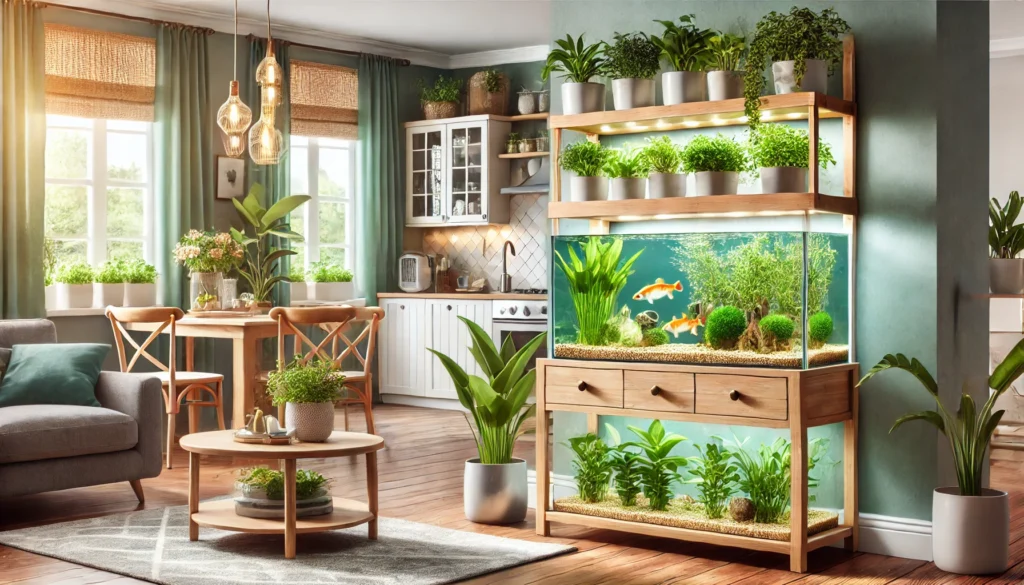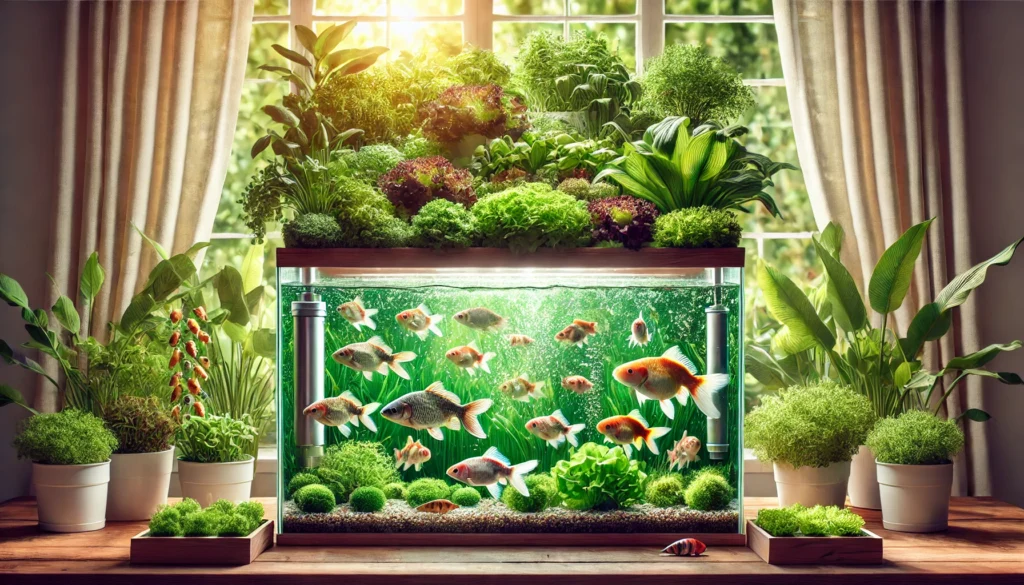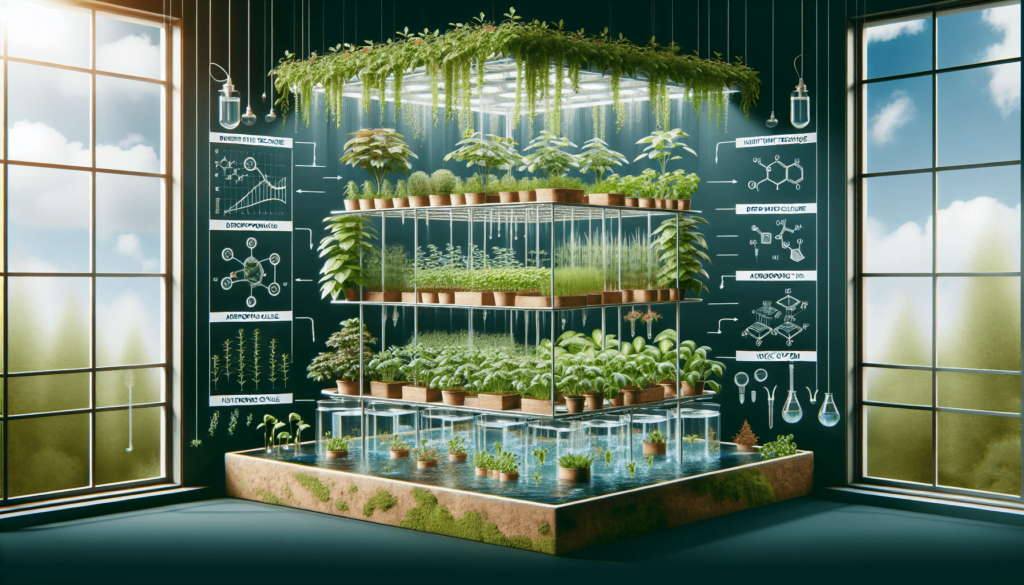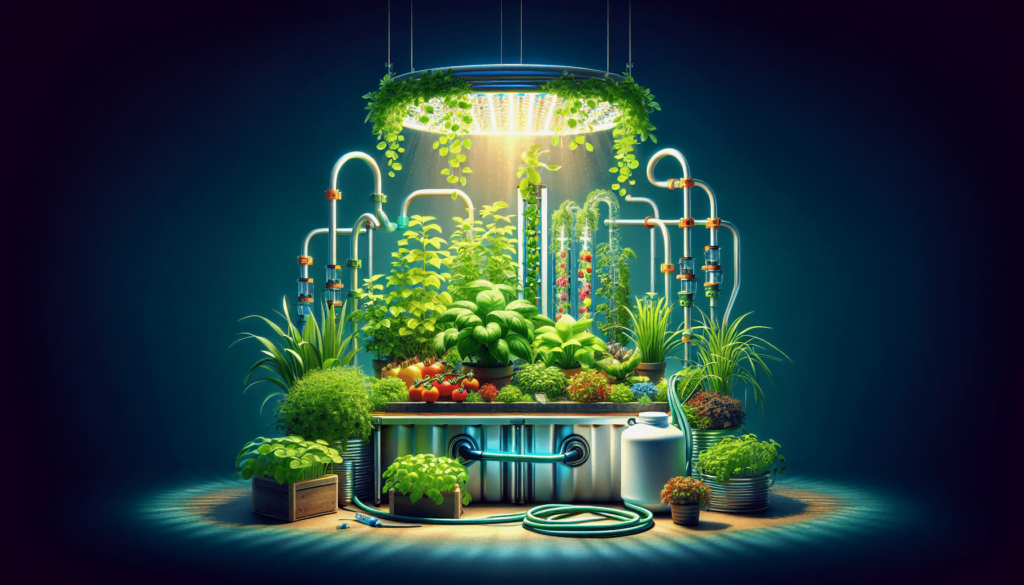Introduction
Imagine growing fresh veggies right in your home, while also taking care of a few friendly fish. Sounds pretty cool, right? Well, that’s the magic of aquaponics—an awesome combination of hydroponics and aquaculture, where plants and fish work together in harmony. 🌿🐟 It’s a sustainable, smart gardening method that not only saves you water but also looks fantastic.
Why should you give it a shot? Think about it—fresh herbs and vegetables whenever you need them, no soil, and far less mess. Plus, a healthy school of fish adds a serene, relaxing touch to your living space. Now let’s explore exactly how this system works and how you can set it up in your home!
What Exactly is Aquaponics?
At its core, aquaponics is all about partnership—it’s like creating a perfect living relationship between fish and plants. Here’s how it goes down: fish produce waste, which is then broken down by bacteria into nutrients that the plants love. In turn, these plants clean the water, which cycles back to the fish. Win-win!
Key Components:
- The Fish Tank: This is the home for your aquatic buddies, like tilapia, goldfish, or koi.
- The Grow Bed for Plants: It’s where you grow herbs, veggies, and even some flowering plants that thrive by absorbing nutrients.
- Beneficial Bacteria: These unsung heroes convert fish waste (ammonia) into nitrates, a type of fertilizer that plants can absorb.
Benefits of Aquaponics at Home
- Sustainability: Aquaponics uses about 90% less water than traditional gardening, making it an eco-friendly option.
- Two-in-One System: You get fresh veggies and herbs and happy fish all in one spot. Perfect for any multitasking enthusiast!
- Year-Round Growth: Set up indoors with proper lighting, and you’ll have a year-round garden, regardless of the season.
- Nature Therapy: Watching fish swim is calming, and tending to your plants adds a lush, green touch to your home—perfect for some much-needed nature therapy.
Getting Started with Aquaponics



Choosing the Right System
Aquaponic systems can sound fancy, but you’ve got some great options for setting up at home. Let’s talk about the three most common setups:
- Media-Based System: In this type, plants grow in a medium like gravel or clay pebbles. The grow bed is flooded and drained, allowing nutrients to be absorbed by the plants. It’s beginner-friendly and requires minimal equipment.
- Deep Water Culture (DWC): Plants float on top of the water, usually on rafts. This setup works well if you have lots of leafy greens to grow.
- Nutrient Film Technique (NFT): A thin stream of water runs over the roots, providing nutrients continuously. This is often used for herbs and small leafy greens in a compact space.
Selecting the Fish
- Best Fish for Beginners: Tilapia is easy to raise and can even end up on your dinner plate. Goldfish and koi are also good options if you’re just in it for aesthetics and ease.
- Feeding the Fish: The quality of fish food directly affects plant health, so choose a balanced, high-quality food—you’re feeding both your fish and plants after all!
Picking the Right Plants
Not every plant loves an aquaponic environment. Here’s what works best:
- Easy-to-Grow Plants: Lettuce, kale, basil, mint, and other leafy greens thrive in aquaponic setups.
- Plants to Avoid: Root veggies like carrots or potatoes don’t do well, and large fruiting plants can be nutrient-hogs that overwhelm the system.

Setting Up Your Home Aquaponics System
Location, Location, Location
- Sunlight: Your plants need sunlight, but indoor systems also work great with grow lights. Choose a bright spot, like near a window, or invest in quality LEDs for consistent light.
- Space Considerations: Aquaponics systems range from tabletop size to full-scale vertical setups. Figure out what fits your space without cramping the room—after all, you’ll need to maintain it comfortably.
DIY vs. Pre-Made Kits
- DIY Systems: If you’re handy and on a budget, consider building your own. PVC pipes, plastic tubs, and a basic pump will get you started.
- Store-Bought Kits: If you want something plug-and-play, consider pre-made aquaponic kits—they come with everything you need and take the guesswork out of getting started.
Common Challenges and How to Overcome Them
- Water Quality Issues: Maintaining good water quality is crucial. Fish produce ammonia, which needs to be processed by bacteria into nitrites and nitrates. Test the water regularly for pH, ammonia, and nitrates.
- Fish Health: Fish that are stressed can impact your plants. Signs like gasping at the surface or changes in behavior may indicate something’s off. Overcrowding is also a big no-no!
- Plant Problems: If your plants look yellow or seem droopy, they may be nutrient-deficient. Sometimes, it’s as simple as giving them more light or adjusting the fish feed.
Image Suggestion: A diagram showing the nitrogen cycle in aquaponics, including ammonia, nitrite, and nitrate flow.
Tips for a Thriving Aquaponic Garden
- Patience is Key: The nitrogen cycle takes time to establish. You’ll need a few weeks for the beneficial bacteria to get going before everything starts running smoothly.
- Test the Water Regularly: A good water test kit will keep you on top of things and prevent nasty surprises.
- Feeding Balance: Don’t overfeed the fish. Uneaten food sinks to the bottom, decomposes, and can upset the balance, leading to problems like algae.
-
%27%20fill-opacity%3D%27.5%27%3E%3Cpath%20fill%3D%22%231e1e1e%22%20fill-opacity%3D%22.5%22%20d%3D%22M236.1%20259h-178V119.5h178z%22%2F%3E%3Cellipse%20fill%3D%22%23fff%22%20fill-opacity%3D%22.5%22%20rx%3D%221%22%20ry%3D%221%22%20transform%3D%22matrix(-2.68551%2061.47019%20-298.54335%20-13.04278%20161%2043)%22%2F%3E%3Cpath%20fill%3D%22%23fff%22%20fill-opacity%3D%22.5%22%20d%3D%22M249.1%207.4l83.2-2.9%2010.4%20298.6-83.2%203zM-39%201.6l84.4%201.5-5.2%20298.8-84.4-1.5z%22%2F%3E%3C%2Fg%3E%3C%2Fsvg%3E) AquaSprouts Aquaponics Kit: Self-Sustaining Desktop Hydroponic Aquarium Ecosystem for Standard 10 Gallon Tanks$174.89
AquaSprouts Aquaponics Kit: Self-Sustaining Desktop Hydroponic Aquarium Ecosystem for Standard 10 Gallon Tanks$174.89 -
Product on sale
%22%20transform%3D%22translate(.6%20.6)%20scale(1.17188)%22%20fill-opacity%3D%22.5%22%3E%3Cellipse%20fill%3D%22%239bad3f%22%20rx%3D%221%22%20ry%3D%221%22%20transform%3D%22matrix(-78.49963%202.60629%20-1.14266%20-34.41628%20124.7%2044.7)%22%2F%3E%3Cellipse%20fill%3D%22%23fff%22%20cx%3D%2217%22%20cy%3D%22158%22%20rx%3D%2255%22%20ry%3D%22160%22%2F%3E%3Cellipse%20fill%3D%22%23fff%22%20cx%3D%22255%22%20cy%3D%22169%22%20rx%3D%2287%22%20ry%3D%2287%22%2F%3E%3Cellipse%20fill%3D%22%239d9ca5%22%20rx%3D%221%22%20ry%3D%221%22%20transform%3D%22rotate(-14%201094.3%20-391.4)%20scale(51.88523%2035.59387)%22%2F%3E%3C%2Fg%3E%3C%2Fsvg%3E) Indoor Aquaponic Garden by Back to the Roots – 3 Gallon Self-Watering, No-Mess Planter and Self-Cleaning Fish Tank for Growing Herbs, Microgreens, Bamboo, Succulents, and…Original price was: $99.99.$67.71Current price is: $67.71.
Indoor Aquaponic Garden by Back to the Roots – 3 Gallon Self-Watering, No-Mess Planter and Self-Cleaning Fish Tank for Growing Herbs, Microgreens, Bamboo, Succulents, and…Original price was: $99.99.$67.71Current price is: $67.71. -
%27%20fill-opacity%3D%27.5%27%3E%3Cellipse%20fill%3D%22%23fff%22%20fill-opacity%3D%22.5%22%20rx%3D%221%22%20ry%3D%221%22%20transform%3D%22matrix(-298.8107%203.22761%20-.57423%20-53.16186%20124.6%2044.2)%22%2F%3E%3Cellipse%20fill%3D%22%230e0e0e%22%20fill-opacity%3D%22.5%22%20rx%3D%221%22%20ry%3D%221%22%20transform%3D%22matrix(-140.67606%20-1.22766%20.72208%20-82.74199%20150.4%20189.9)%22%2F%3E%3Cellipse%20fill%3D%22%23fff%22%20fill-opacity%3D%22.5%22%20rx%3D%221%22%20ry%3D%221%22%20transform%3D%22matrix(298.81871%20-2.37199%20.3495%2044.02834%20122.9%2036.4)%22%2F%3E%3Cpath%20fill%3D%22%23fff%22%20fill-opacity%3D%22.5%22%20d%3D%22M-3.3%20245.2L69%20283.7l-24.8%2046.5-72.4-38.5z%22%2F%3E%3C%2Fg%3E%3C%2Fsvg%3E) Pennington Aquagarden$599.99
Pennington Aquagarden$599.99
Conclusion
Aquaponics is a fantastic way to combine the calming nature of fishkeeping with the productive joy of gardening. It’s sustainable, educational, and there’s nothing quite like watching a thriving mini-ecosystem in your living room. Not only do you get fresh herbs and veggies year-round, but you also end up with a beautiful, vibrant setup that’s as much a part of your home as any piece of furniture.
Ready to get started on your aquaponics journey? It’s easier than you think, and before long, you’ll have both happy fish and healthy plants to enjoy. If you’ve already started, share your experiences and setup in the comments—let’s get this community growing! 🌱✨
Forum
Got something to share or a question to ask? Jump in and start a conversation! Whether it’s tips, advice, or just sharing your experiences, we’d love to hear from you. Don’t be shy—your input could inspire or help someone else!- This forum has 1 topic, and was last updated 10 months, 2 weeks ago by .
- Topic
- Voices
- Last Post
- You must be logged in to create new topics.






